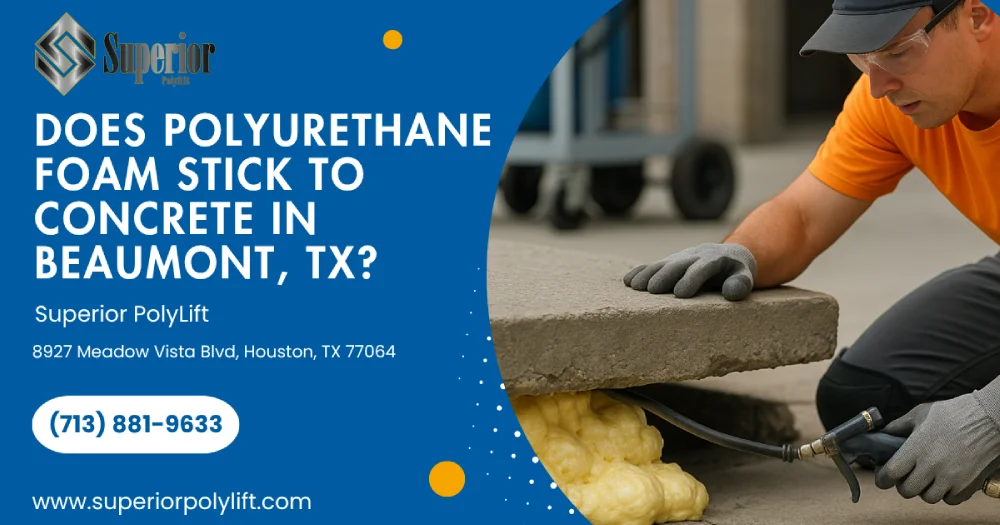
Yes—polyurethane foam bonds tightly to concrete, delivering industrial-grade concrete lifting and foundation repair across Beaumont, TX. Technicians inject the foam beneath a concrete slab, where it expands, fills voids, and instantly levels sunken sections. Also known as PolyLift, polyurethane concrete lifting keeps structural assets aligned without lengthy downtime or invasive demolition.
Beaumont’s clay-rich soils, high water table, and Gulf Coast humidity can trigger foundation problems, sinking concrete, and uneven industrial floors. If you’ve priced mudjacking, grouting, or full replacement, you may wonder whether foam actually adheres or merely props up the slab. The guide below answers that concern and more, drawing on field data from major petrochemical, distribution, and port facilities that required scalable concrete leveling services—not small residential fixes.
Polyurethane concrete foam does more than fill gaps; it “keys” into microscopic pores on the underside of the slab, producing a bond strong enough to withstand forklifts, gantry cranes, and heavy vehicular traffic.
Once Part A (isocyanate) and Part B (resin) mix, the liquid permeates micro-capillaries. As it expands—up to 30× original volume—the foam creates a mechanical grip. Simultaneously, a durable skin forms, acting as a moisture-blocking sealant that protects against water pooling and hydrostatic pressure during hurricane season.
| Material Pairing | Typical Adhesion | Field Notes |
| Polyurethane → Concrete | 120-250 | Tested after 1000 freeze-thaw cycles |
| Epoxy → Concrete | 200-300 | Strong, but no lifting capability |
| Cement Grout → Concrete | 30-60 | Relies on mass not adhesion |
Understanding the application process helps asset managers coordinate crews, safety, and logistics.
Technicians run GPR scans, take elevation readings, and analyze the situation to identify the root cause of settlement—be it water pooling, poor compaction, or vibration.
5/8-inch ports minimize surface scarring. Making foam through these small holes is non-invasive and keeps slabs intact.
Computer-calibrated pumps place the foam beneath the concrete. Densities from 4-6 lb/ft³ support heavy machinery; lower densities suit pedestrian aprons.
Ports are sealed, surfaces cleaned, and live-load tests confirm the slab is perfectly level and stable.
Cement slurry (100-140 lb/ft³) can overload clay and re-settle, plus cure time delays traffic for days.
Great for crack sealing but lacks volumetric expansion to level broad sunken pads.
Delivers new concrete but demands weeks of shutdown, heavy demolition, and disposal costs.
Polyurethane concrete lifting via Superior PolyLift™ reliably bonds to industrial slabs, solves foundation issues, and outperforms mudjacking or grouting in Beaumont, TX. Whether you manage petrochemical plants, intermodal terminals, or warehousing complexes, this non-invasive technique delivers long-lasting stabilization, rapid return to service, and quantifiable ROI. Ready to identify the root cause of uneven concrete and secure a tailored repair plan? Contact our team for a free inspection, an on-site engineering review, and a detailed proposal that meets your performance goals while honoring budget constraints.

Explore how our expertise can benefit your project. Reach out to our team for a consultation and discover the best solutions for your needs.
Copyright © All rights reserved. 2024 • Terms of Use and Privacy Policy • Internet Marketing by Authority Solutions®